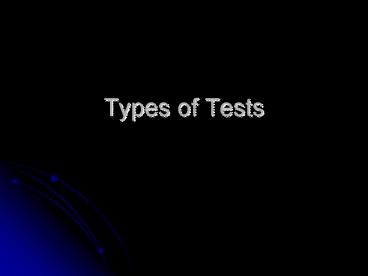Types of Tests - PowerPoint PPT Presentation
1 / 27
Title:
Types of Tests
Description:
In what ways are tests good/bad? Backwash effect. Impact of tests on teaching and learning. Beneficial/harmful backwash effect. Ex. Testing and Assessment ... – PowerPoint PPT presentation
Number of Views:7640
Avg rating:3.0/5.0
Title: Types of Tests
1
Types of Tests
2
- Why do we need tests?
3
- Test scores educational decisions
- inference
- Test scores performance/ true
ability
4
- In what ways are tests good/bad?
5
Backwash effect
- Impact of tests on teaching and learning
- Beneficial/harmful backwash effect
- Ex.
6
Testing and Assessment
- Assessment tests, projects, observation of
performance, portfolios, etc. - Tests are one form of assessment
7
Formative vs. summative assessment
- Formative assessment
- check progress of learning
- Summative assessment
- end of program check
8
Types of tests (purposes)
- Proficiency tests
- Diagnostic tests
- Placement tests
- Achievement tests
- Aptitude tests
- Admission tests
- Progress tests
- Language dominance tests
9
Proficiency tests
- Measure general ability in a language
- Regardless of previous training
10
Diagnostic tests
- Identify students strengths and weaknesses
- To benefit future instruction
- Difficult to construct. Lack of good ones.
11
Placement tests
- To assign students to classes/programs
appropriate to their level of proficiency - Define characteristics of each level of
proficiency
12
Achievement tests
- Measure how successful students are in achieving
objectives of a lesson/course/curriculum - Closely related to the content of a particular
lesson/course/ curriculum - Syllabus content approach OR course objectives
approach? - Final achievement tests / progress achievement
tests (formative assessment) - Frequency?
13
Aptitude tests
- To predict a persons future success in learning
a (any) foreign language - Taken before actual learning
14
Admission tests
- to provide information about whether a candidate
is likely to succeed
15
Progress tests
- teststo assess students mastery of the course
material (during the course)
16
Language dominance tests
- to assess bilingual learners relative strength
of the 2 languages
17
Direct vs. indirect testing
- Direct testing
- -Requires Ss to perform the skill to be measured
- Indirect testing
- -Measures the abilities underlying the skills to
be measured - -Ex. A writing test that requires Ss to identify
grammatical errors in sentences - Semi-direct testing
- -tape recorded speaking test
18
Problems
- Direct testing
- -practicality (limited resources)
- -small sample of tasks
- Indirect testing
- -nature of the trait to be measured
- -relationship b/w test performance and skills
tested
19
Discrete point vs. integrative tests
- Discrete point tests
- -Focus on one linguistic element at a time
- -Assumption language can be broken down into
separate element - -tend to be indirect
- Integrative tests
- -Requires to students to combine many linguistic
elements - -Unitary trait/competence hypothesis (Oller)
- -tend to be direct
- -Ex. Composition, dictation, cloze tests,
note-taking
20
Norm v.s. Criterion-referenced tests
21
Criterion vs. Norm-referenced tests
- Strengths and weaknesses?
22
Objective vs. subjective tests
- Scoring of tests
- Objective tests
- -Requires no judgment from the scorer
- -Ex. Multiple choice, T/F tests
- Subjective tests
- -Requires judgment from the scorer
- -Ex. Essay questions, composition
- Different degrees of subjectivity
23
History of language testing
- Prescientific period (b/f 1950s)
- GTM, reading-oriented methods
- Psychometric-structuralist period (1950s-1960s)
- structural linguistics, behavioral psychology,
discrete point tests - Integrative-sociolinguistic period (a/f 1960s)
- communicative language ability
24
- What is communicative competence?
25
Communicative competence
- Grammatical competence
- Discourse competence
- Sociolinguistic competence
- Strategic competence
26
Communicative language testing
- Communicative nature of tasks
- Authenticity of tasks
27
Computer Adaptive Testing (CAT)
- Saves time and effort
- Start with average level of difficulty,
lower/increase levels of difficulty according to
test takers performance - Needs a bank of items graded by difficulty































